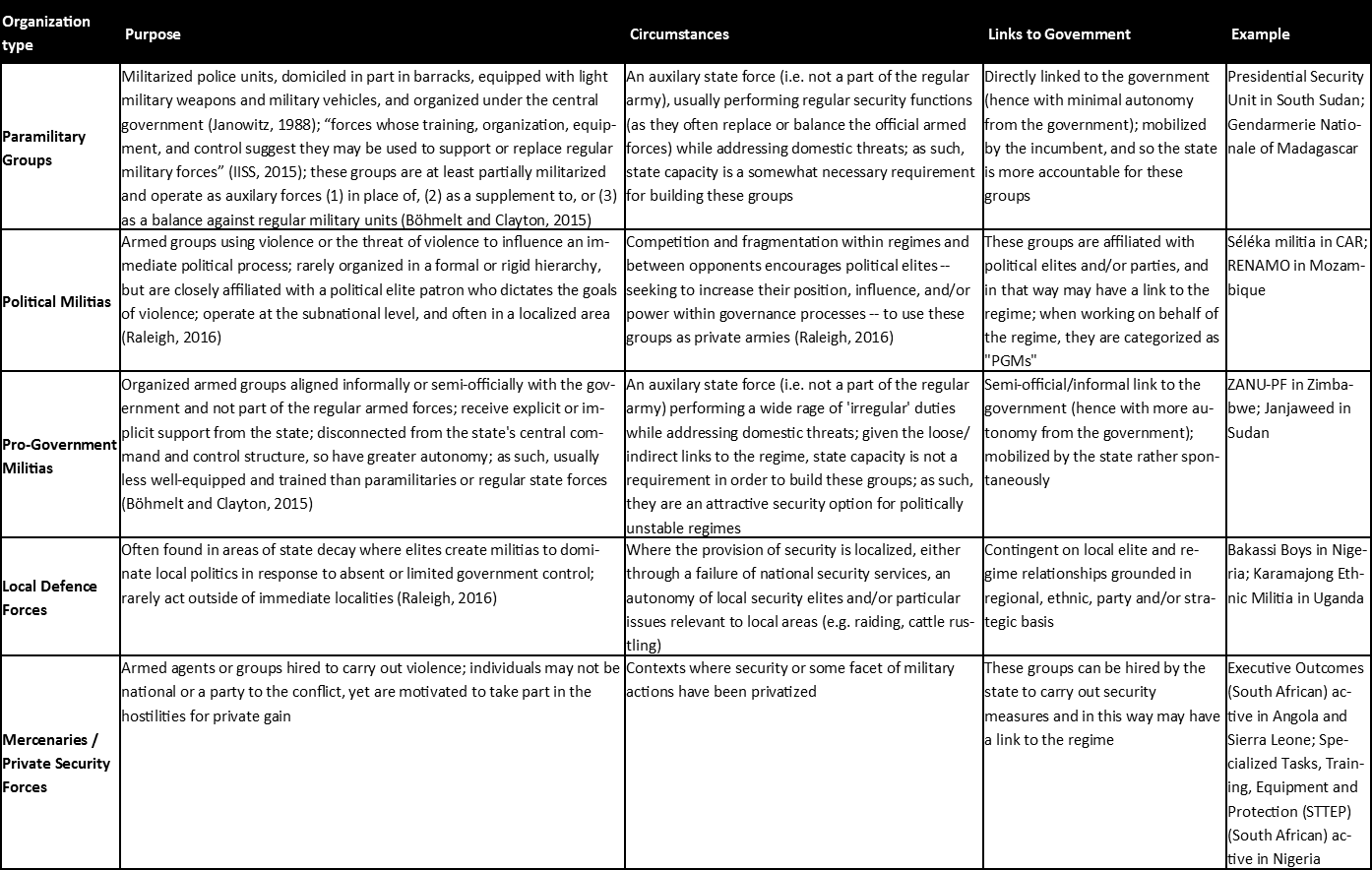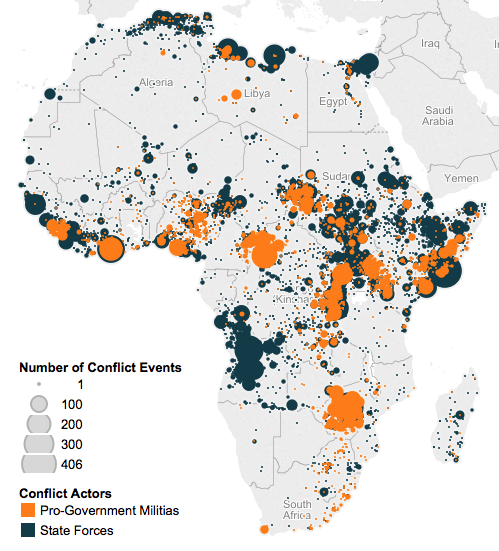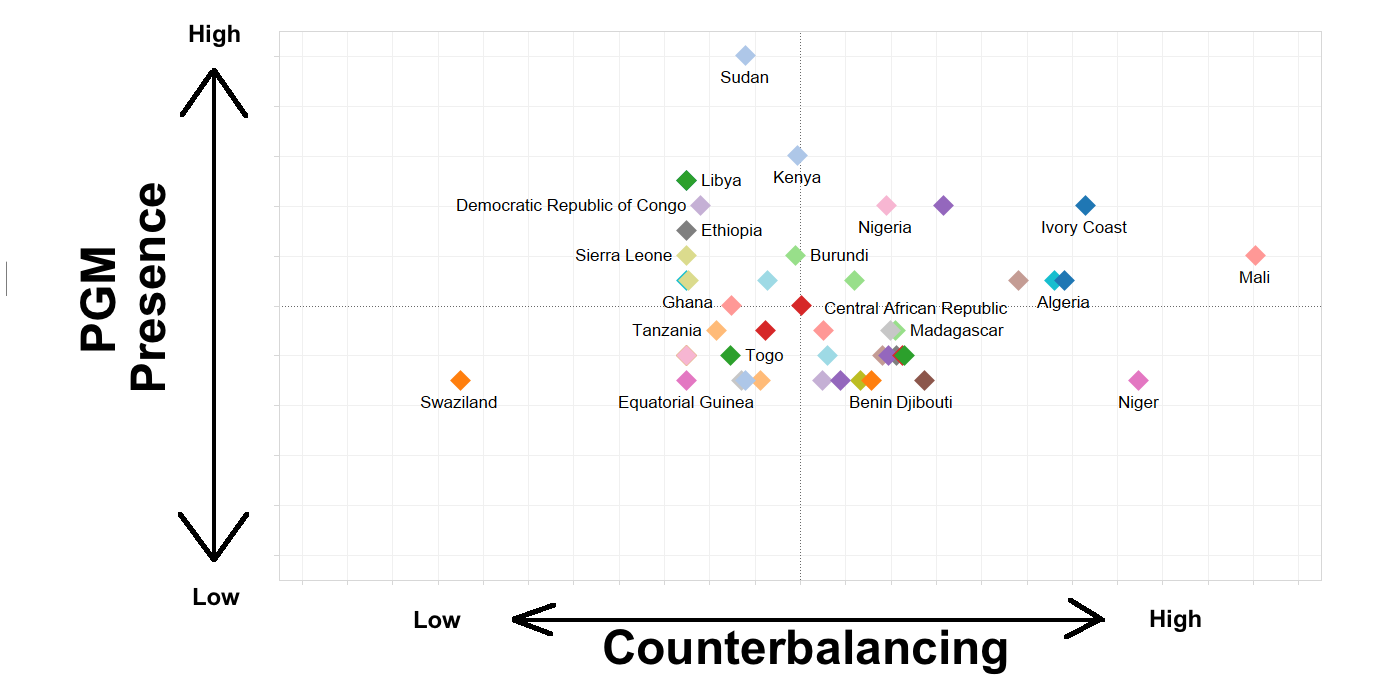Regimes in developing states engage in practices of ‘violence management’ that involve both offensive and defensive strategies to contain, repress, and curtail various domestic threats. Some of these strategies include public repression, counterbalancing (fragmenting military and police units through offering varying levels of support, equipping units differently, and the creation of paramilitary forces) and supporting pro-government militias (PGMs) to combat opponents within and outside of the regime. A new working paper by Raleigh and Kishi presents a ‘violence management’ framework through which to understand why, where, and when states employ these tactics, and introduces a new dataset on pro-government militias – PGM-Set – to test these hypotheses.
African leaders face a high internal risk in the form of coups, purges, putsches, and mutinies; these are more common than civil wars (Roessler, 2011). To mitigate or lessen these threats, states may use repression tactics (Escribà-Folch, 2013); intimidating, targeting, and/or killing potential opposition is effective in quelling threats from organized groups (Hafner-Burton, Hyde, and Jablonski, 2010) and assisting regimes to stay in power. African regimes often use repression to eradicate competition and subordinate civilian reform and revolt in order to ensure their survival (see Clapham, 1996). Regimes also decentralize security forces, thereby limiting the ability of the military to overwhelm the executive. Counterbalancing strategies through the establishment of paramilitary forces can aid in guarding against internal threats. Auxiliary state forces operate as supplements to particular branches and elites in governments, as the internal fractures within developing countries’ institutional structures are often significant and exert a far greater threat to the stability of the state than external threats. Finally, PGM forces loyal to a regime are a cheap alternative to state or paramilitaries. PGM activity rises in response to increased domestic threats to the state. Militias are increasingly becoming the primary agent of conflict across the African continent, and operate as ‘private armies’ for political elites vying for increased influence (Raleigh, 2016) – see Table 1 for a presentation of common armed group types under consideration.
Table 1. Definitions of Agents of Violence Management
Previous studies contend that PGMs are used in places where the state does not have the capacity to carry out violence itself (see: Jones, 2012; Peic, 2014). This is the ‘weak state capacity’ argument. Another ‘accountability’ argument suggests these forces are employed when regimes do not want to carry out particularly brutal forms of violence itself for fear of reprisal (see: Ron, 2002; Alvarez, 2006; Staniland, 2012; Mitchell, Carey, and Butler, 2014; Carey, Colaresi, and Mitchell, 2015). However, Figure 1 maps the locations of all organized, armed conflict events in Africa between 1997 and 2014, specifying between PGMs and state conflict agents; this suggests that the state is largely active in all of the same areas as PGMs. States also continue to carry out particularly brutal attacks themselves. For example, while PGMs were active in South Sudan, there are reports of South Sudanese military forces killing up to one thousand Nuer civilians in late 2013. That the practices of PGMs and state forces overlap suggests that capacity and accountability may not be the factors driving states to outsource violence.
Figure 1: Organized Armed Conflict Involving Pro-Government Militias and State Conflict Actors, Africa, 1997-2014.
Raleigh and Kishi argue that these different organizations and responses – PGM activity, counterbalancing efforts, and the use of state repression – are specifically designed to deal with various types and scales of threat. Co-occurring counterbalancing and PGM activity (see Figure 2) suggests that these actions and groups have distinct purposes, and one regime strategy does not exclude the need for others.
Figure 2. PGM Presence versus Counterbalancing
PGMs offer several attractive benefits to regimes:
- PGMs are a flexible and inexpensive force that can be deployed when necessary (e.g. election periods) (see Carey, Colaresi, and Mitchell, 2012).
- PGMs provide local knowledge and representation, especially in cases where the state relies on indirect rule via local intermediaries in areas within its territory in which it has inconsistent control (see Mann, 2004; Gerlach, 2010; Ahram, 2014).
- PGMs are flexible in their use, formality, and instruction, and do not require formalization and associated responsibility (see Carey et al., 2012).
Across African states from 1997 through 2014, just 7% of civil war events were committed by PGMs, while over half of all militia activity outside of civil war periods are committed by PGMs. The rates of activity outside of traditional civil war contexts suggest that PGMs are far more than a replacement force for incapable state militaries.
PGMs and their activities are of concern as they constitute a grave threat to civilian safety generally: of all active militias operating on behalf of political elites (e.g. rebel leaders, politicians, political parties, warlords, military, government officials, etc.), those associated with the state have the most pervasive and negative impact on civilians. Over 10% more PGM conflict activity targets civilians relative to non-PGM militias; and these actions are more lethal relative to other militias. On average, each instance of civilian targeting by a PGM leads to three times more civilian deaths than those carried out by other militias.
This report was originally featured in the April ACLED-Africa Conflict Trends Report.








